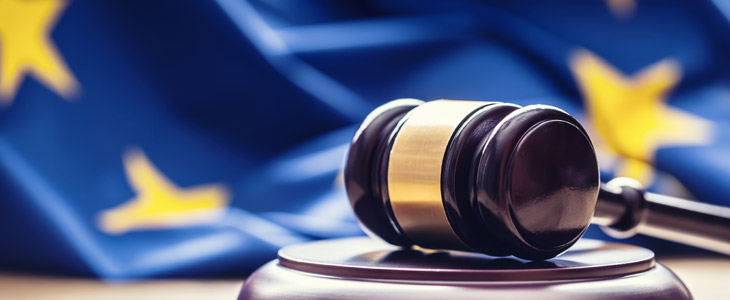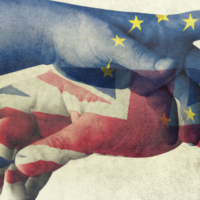
This article is the first part of a three-part series on the European Anti-Human Trafficking Legal and Policy Framework.
This article provides an overview of the European anti-human trafficking legal and policy framework by focusing on the Council of Europe and the EU. In addition, it highlights extensive legal and policy instruments as well as strategic documents and resources that address human trafficking at the European level.
The Council of Europe
Convention for the Protection of Human Rights and Fundamental Freedoms
The Convention for the Protection of Human Rights and Fundamental Freedoms, better known as the European Convention on Human Rights (ECHR), is an international treaty designed to protect human rights. The treaty binds the 47 member states2 of the Council of Europe. It is important to distinguish them from the EU member states, which are comprised of 27 countries that partly delegate sovereignty in order to make decisions on matters of common interest at the European level. In fact, all 27 member states of the EU are members of the Council of Europe and none of them have ever joined the EU without first being part of the Council of Europe.
The ECHR entered into force in 1953, it was drafted based on the Universal Declaration of Human Rights (UDHR) and adopted by the General Assembly of the UN in 1948. In Article 4, the UDHR states that ‘[no] one shall be held in slavery or servitude; slavery and the slave trade shall be prohibited in all their forms.’ 3Similarly, the ECHR lists rights and freedoms in Section I and prohibits slavery and forced labour in Article 4, which states, ‘[no] one shall be held in slavery or servitude’ and ‘[no] one shall be required to perform forced or compulsory labour.’ In this regard, the ECHR prohibits human trafficking as it is considered to be a form of modern slavery.
The Council of Europe is the continent’s leading human rights organisation, which aims at promoting human rights, democracy and the rule of law through international conventions. The 47 members of the Council of Europe signed the ECHR, which established the European Court of Human Rights in Section II, and the establishment of the Court in Article 194 to create a judicial body that oversees the implementation of the convention in the 47 member states. The Council of Europe also monitors the progress of its member states on human rights by making recommendations through monitoring bodies.
The Group of Experts on Action against Trafficking in Human Beings (GRETA) is the independent expert monitoring body that is responsible for monitoring the anti-human trafficking progress of the Council of Europe’s member states.5 GRETA is composed of 15 independent and impartial experts from various backgrounds and multidisciplinary expertise who are elected by the Council of Europe’s Committee of the Parties. The main responsibility of GRETA is to monitor the implementation of the Council of Europe Convention on Action against Trafficking in Human Beings by the convention’s parties. In this regard, GRETA publishes country reports6 as well as general reports on its activities,7 organises three plenary meetings once a year and carries out evaluation visits to member states.
Council of Europe Convention on Action Against Trafficking in Human Beings
The Council of Europe Convention on Action against Trafficking in Human Beings8 is a treaty adopted by the Council of Europe’s Committee of Ministers that entered into force in 2008. The convention is centred on human rights as it focuses on the protection of victims of human trafficking as well as the safeguard of their rights. In this regard, the convention defines human trafficking as ‘a violation of human rights and an offence to the dignity and integrity of the human being.’9 It is worth mentioning that the convention is not restricted to the Council of Europe’s member states, given that non-members of the Council of Europe can become parties of the convention. Chapter one of this convention defines the purposes, scope, non-discrimination principle and definitions, and further clarifies these in the first four articles.
Article 1 specifies the three main purposes of the convention:
- "To prevent and combat trafficking in human beings, while guaranteeing gender equality
- To protect the human rights of the victims of trafficking, design a comprehensive framework for the protection and assistance of victims and witnesses, while guaranteeing gender equality, as well as to ensure effective investigation and prosecution
- To promote international cooperation on action against trafficking in human beings"10
Article 2 determines the scope of the convention, which "shall apply to all forms of trafficking in human beings, whether national or transnational, whether or not connected with organised crime."11
Article 3 establishes a non-discrimination principle that states the following,
"the implementation of the provisions of [the] Convention by Parties, in particular the enjoyment of measures to protect and promote the rights of victims, shall be secured without discrimination on any ground such as sex, race, colour, language, religion, political or other opinion, national or social origin, association with a national minority, property, birth or other status."12
Article 4 defines human trafficking according to the Article 3, paragraph (a) of Annex 2 of the "Protocol to Prevent, Suppress and Punish Trafficking in Persons, Especially Women and Children, supplementing the United Nations Convention against Transnational Organized Crime" adopted by the United Nations Office on Drugs and Crime (UNODC) General Assembly.13 The latter is the first national instrument with agreed definitions on human trafficking and human smuggling.
It is worth noting that the convention sets up GRETA as the specific monitoring mechanism that ‘shall monitor the implementation of this Convention by the Parties.’14
European Union
Treaty on the Functioning of the EU
The Treaty on the Functioning of the European Union15 (TFEU) aims at organising the function of the EU and determines the areas and delimitation, as well as the arrangements for exercising its competences. The TFEU entered into force in 1958 and constitutes the foundation of the EU along with the Treaty on European Union. These two treaties are referred to as ‘the Treaties.’
The TFEU defines human trafficking as a serious and transnational crime in Title 5 ‘Area of Freedom, Security and Justice’, Chapter 4 ‘Judicial Cooperation in Criminal Matters:’ Article 83, Paragraph 1:
“The European Parliament and the Council may, by means of directives adopted in accordance with the ordinary legislative procedure, establish minimum rules concerning the definition of criminal offences and sanctions in the areas of particularly serious crime with a cross-border dimension resulting from the nature or impact of such offences or from a special need to combat them on a common basis.
These areas of crime are the following: terrorism, trafficking in human beings and sexual exploitation of women and children, illicit drug trafficking, illicit arms trafficking, money laundering, corruption, counterfeiting of means of payment, computer crime and organized crime.”
It is worth noting that upon the European Parliament’s consent, the Council of Europe may identify other criminal areas based on the criteria specified in this paragraph as well as the developments in crime. This article is closely linked to Article 79, Paragraphs 1 and 2.
In Paragraph 1, the TFEU requires the EU to act in order to prevent human trafficking:
“The Union shall develop a common immigration policy aimed at ensuring, at all stages, the efficient management of migration flows, fair treatment of third-country nationals residing legally in Member States, and the prevention of, and enhanced measures to combat, illegal immigration and trafficking in human beings.”
In Paragraph 2 (d), the TFEU requires the Council of Europe and the European Parliament to act against human trafficking:
“For the purposes of paragraph 1, the European Parliament and the Council, acting in accordance with the ordinary legislative procedure, shall adopt measures in the following areas: […] combating trafficking in persons, in particular women and children.”
Charter of Fundamental Rights of the EU
The Charter of Fundamental Rights of the European Union16 establishes the personal, civic, political, economic and social rights of the people within the 27 member states of the EU. The charter aims at increasing the visibility and clarity of these fundamental rights and was entered into force in 2009. The charter is consistent with the ECHR as it contains rights and freedoms that stem from it under the following six titles:
- Dignity
- Freedoms
- Equality
- Solidarity
- Citizens' rights
- Justice
Human trafficking is prohibited under Title 1, Article 5, which states:
- No one shall be held in slavery or servitude
- No one shall be required to perform forced or compulsory labour
- Trafficking in human beings is prohibited
The Stockholm Programme—An Open and Secure Europe Serving and Protecting the Citizens
The Stockholm Programme17 focuses on cooperation with regards to policy areas of justice and home affairs of the European member states. It was adopted by the European Council in 2009 and established a framework from 2010 to 2014.
The programme particularly highlights human trafficking and calls for action in Section 4.4.2, ‘Trafficking in human beings’:
“The European Council finds it necessary to strengthen and enhance the prevention and combating of trafficking and smuggling. This calls for a coordinated and coherent policy response which goes beyond the area of freedom, security and justice and, while taking account of new forms of exploitation, includes external relations, development cooperation, social affairs and employment, education and health, gender equality and non-discrimination. It should also benefit from a broad dialogue between all stakeholders, not least including civil society, and be guided by an improved understanding and research of trafficking and smuggling at EU and international levels.”18
In this regard, it is worth mentioning the ‘Action-Oriented Paper (AOP) on strengthening the EU external dimension on action against trafficking in human beings’,19 which aims at strengthening the commitment and coordinated action of the EU and its member states to prevent all forms of human trafficking.
It was followed by two reports on the implementation of the AOP as the European Council called for the implementation of the latter to its fullest extent.
- "Action-Oriented Paper on strengthening the EU external dimension on action against trafficking in human beings – first implementation report/update of information on Member States' external action’20
- Action-Oriented Paper on strengthening the EU external dimension on action against trafficking in human beings – second implementation report/update of information on Member States' external action"21
Conclusion
The EU establishes fundamentals rights that prohibit human trafficking through the charter of fundamental rights and defines these in the TFEU as a serious and transnational crime. By contrast, the Council of Europe, aims at protecting human rights through the Convention for the Protection of Human Rights and Fundamental Freedoms by prohibiting human trafficking as a form of slavery or servitude and forced or compulsory labour. In this regard, the Council of Europe goes one step further by adopting a comprehensive treaty through the Council of Europe Convention on Action Against Trafficking in Human Beings by considering all forms of human trafficking and focusing on victims regardless of their age and gender.
As a result, the legal and policy framework of the Council of Europe and the EU outlined in this article constitute the basis of what the EU has put in place to address human trafficking, namely a comprehensive legal and policy framework anchored in the EU’s Anti-trafficking Directive.
Jonathan Dupont, analyst, financial intelligence unit, Vilnius, Lithuania, jonathandupont@protonmail.com
- “Details of Treaty No.005, Convention for the Protection of Human Rights and Fundamental Freedoms,” Council of Europe, https://www.coe.int/en/web/conventions/full-list/-/conventions/treaty/005.
- “Our member States,” Council of Europe, https://www.coe.int/en/web/about-us/our-member-states.
- “Universal Declaration of Human Rights,” United Nations, https://www.un.org/en/universal-declaration-human-rights/.
- “Convention for the Protection of Human Rights and Fundamental Freedoms as amended by Protocols No. 11 and No. 14,” Council of Europe, https://www.coe.int/en/web/conventions/full-list/-/conventions/rms/0900001680063765
- “GRETA,” Council of Europe, https://www.coe.int/en/web/anti-human-trafficking/greta.
- “Country monitoring,” Council of Europe, https://www.coe.int/en/web/anti-human-trafficking/country-monitoring-work.
- “General Reports on GRETA’s activities,” Council of Europe, https://www.coe.int/en/web/anti-human-trafficking/general-reports.
- “Council of Europe Convention on Action against Trafficking in Human Beings,” Council of Europe, 2 February 2008, https://www.coe.int/en/web/conventions/full-list/-/conventions/treaty/197.
- “Council of Europe Convention on Action against Trafficking in Human Beings,” Council of Europe, https://rm.coe.int/CoERMPublicCommonSearchServices/DisplayDCTMContent?documentId=090000168008371d
- Ibid.
- Ibid.
- Ibid.
- “United Nations Convention against Transnational Organized Crime and the Protocols Thereto,” United Nations Office on Drugs and Crime, 29 September 2003, https://www.unodc.org/unodc/en/organized-crime/intro/UNTOC.html.
- “Council of Europe Convention on Action against Trafficking in Human Beings,” Council of Europe, https://rm.coe.int/CoERMPublicCommonSearchServices/DisplayDCTMContent?documentId=090000168008371d. See Chapter VII, Article 36.
- “Consolidated version of the Treaty on the Functioning of the European Union,” EUR-Lex: https://eur-lex.europa.eu/eli/treaty/tfeu_2012/oj.
- “Charter of Fundamental Rights of the European Union,” EUR-Lex: https://eur-lex.europa.eu/legal-content/EN/TXT/?uri=CELEX:12012P/TXT.
- “The Stockholm Programme – An open and secure Europe serving and protecting
the citizens,” Council of the European Union, 19 November 2009, https://ec.europa.eu/anti-trafficking/sites/antitrafficking/files/the_stockholm_programme_-_an_open_and_secure_europe_en_0.pdf. - Ibid., p. 44.
- “Action-Oriented Paper on strengthening the EU external dimension on action against trafficking in human beings,” Council of the European Union, 2 December 2009, https://ec.europa.eu/anti-trafficking/sites/antitrafficking/files/action_oriented_paper_on_actions_against_trafficking_en_1.pdf.
- “Action-Oriented Paper on strengthening the EU external dimension on action against trafficking in human beings – first implementation report/update of information on Member States' external action,” Council of the European Union, 4 July 2011, https://ec.europa.eu/anti-trafficking/sites/antitrafficking/files/first_report_on_eu_external_dimension_en_1.pdf.
- “Action-Oriented Paper on strengthening the EU external dimension on action against trafficking in human beings – second implementation report/update of information on Member States' external action”, Council of the European Union, 3 December 2012, https://ec.europa.eu/anti-trafficking/sites/antitrafficking/files/action_oriented_paper_on_strengthening_the_eu_external_dimension_against_trafficking_in_human_beings_-_second_implementation_1.pdf.










